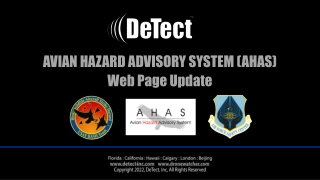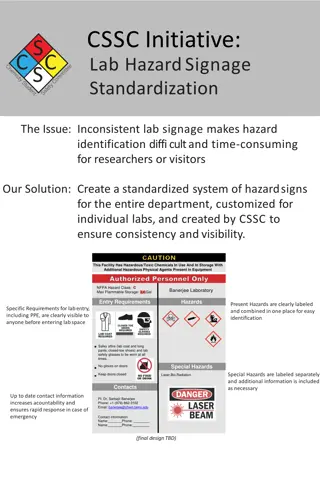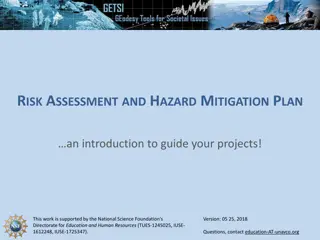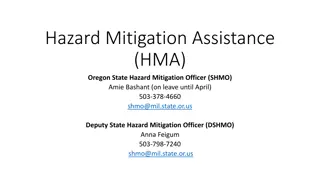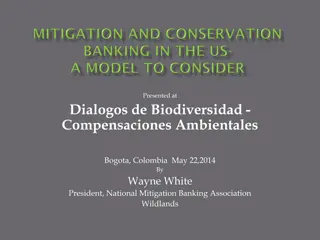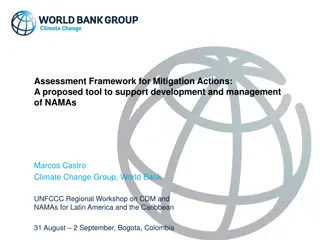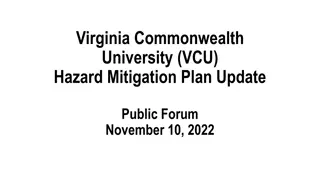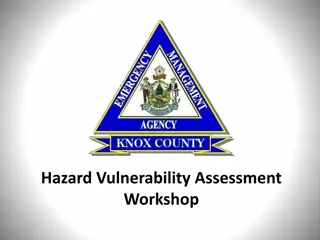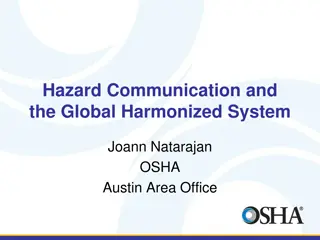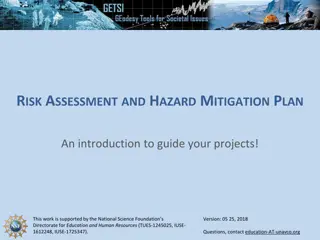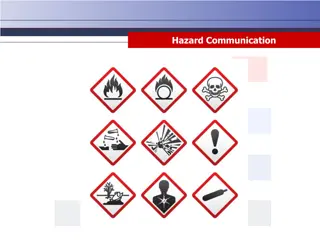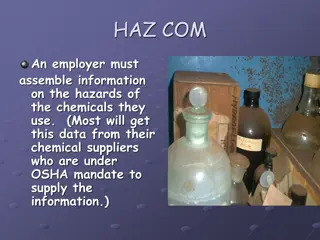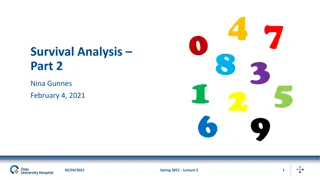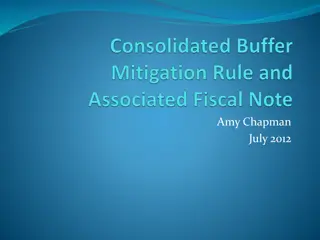Importance of Hazard Mitigation Plans for Scott County
Hazard Mitigation Plans are crucial for Scott County as they allow the county and participating jurisdictions to qualify for FEMA grant funding by minimizing disaster effects before they occur. Scott County has a current plan approved by FEMA, adopted in 2017, and set to expire in November 2022. The planning process involves determining the area, building a team, assessing risks, developing mitigation strategies, and adopting the plan.
Download Presentation

Please find below an Image/Link to download the presentation.
The content on the website is provided AS IS for your information and personal use only. It may not be sold, licensed, or shared on other websites without obtaining consent from the author. Download presentation by click this link. If you encounter any issues during the download, it is possible that the publisher has removed the file from their server.
E N D
Presentation Transcript
A pre-disaster plan meant to minimize the effects of a disaster before one strikes. What is a Hazard Mitigation Plan? This is not a disaster response plan.
Why does Scott County need a FEMA Approved Hazard Mitigation Plan? Per 44 CFR 201.4(a)(1)- For all disasters declared on or after November 1, 2004, all states, local governments, and tribes must participate in a FEMAapproved Hazard Mitigation Plan in order to become eligible for all types of FEMAgrant funding.
Hazard Mitigation Grant Program (HMGP) Follows Disaster Declaration Building Resilient Infrastructure and Communities (BRIC) FEMA Mitigation Grants Awarded Annually, Nationally Competitive Flood Mitigation Assistance (FMA) *Participation in approved Hazard Mitigation Plan required
Not Just the Countys Plan If the county has a current FEMA approved Hazard Mitigation Plan, the county, along with participating jurisdictions, become eligible to apply for FEMA grant funding. It is not enough for the county to have an approved plan, a jurisdiction must participate by assisting with plan development and adopting the plan in order to be eligible for grant funding.
Scott County adopted its first hazard mitigation plan in 2009. Following the expiration of that plan, Scott County received funding to update the plan in 2015. History The current Scott County Hazard Mitigation Plan was approved by FEMA and adopted by participating jurisdictions in 2017. The current plan expires November 19, 2022.
Task 1-Determine Planning Area and Resources Task 2-Build Planning Team and Create Outreach Strategy Hazard Mitigation Planning Process Task 3-Review Community Capabilities Task 4-Conduct Risk Assessment Task 5-Develop Mitigation Strategy Task 6-Review, Revise, and Submit Plan Task 7-Adopt Plan
Task 1-Determine Planning Area and Resources Old Plan Scott County City of Waldron Waldron School District New Plan Scott County City of Waldron-New Mayor Waldron School District-New Superintendent
Task 2-Build Planning Team and Create Outreach Strategy Building Code Enforcement Emergency Management Fire Departments/Districts Floodplain Administration Geographic Information Systems Parks and Recreation/Tourism Planning/Zoning Community/Economic Development Public Information Office Storm Water Management Road/Street Departments Regional Planning Agency City Council/Quorum Court Planning Commission Public Works Special Interest Groups
Responsibilities of the Planning Team Attend Meetings Provide Data for Risk Assessment Identify Community Assets Assist with Mitigation Action Items Assist with Public Involvement Review Drafts of Plan Adopt Plan
Create an Outreach Strategy An Outreach Strategy identifies what we need to accomplish through our outreach efforts, who to involve in the process, and how/when to effectively engage the community. 1. Planning Team (County, City, School District, and Partners) 2. Stakeholders (any person, group, or institution that can affect or be affected by a course of action) 3. Public; a survey will be provided that you can include on your websites and social media sites
Task 3-Review Community Capabilities For multi-jurisdictional plans, the capabilities of each participating jurisdiction must be individually reviewed and documented. In a plan update, the planning team ensures capabilities are documented sufficiently and highlights any capability changes from the previous plan.
The primary types of capabilities for reducing long-term vulnerability through mitigation planning are the following; Planning and Regulatory Administrative and Technical Financial Education and Outreach A worksheet has been provided to the county and each city to help accomplish this.
Task 4-Conduct Risk Assessment Step 1 Describe Hazards Step 2 Identify Community Assets Step 3 Analyze Risks Step 4 Summarize Vulnerability
Task 4-Conduct a Risk Assessment Step 1 Describe Hazards Location of the geographic area that are affected by hazards, such as floodplains. Floods Dam Failure Extent of the magnitude defines the characteristics of the hazard regardless of the people and property it affects. Tornado-Enhanced Fujita Scale Earthquake-Richter Scale/ Modified Mercalli Scale Drought-Palmer Drought Severity Index
Task 4-Conduct a Risk Assessment Step 1 Describe Hazards Previous occurrences help determine the likelihood of future events and predict potential impacts National Climatic Data Center Local Data Probability of future events using historical frequencies or statistical probabilities which often refer to events of a specific size or strength.
Task 4-Conduct a Risk Assessment Step 2 Identify Community Assets People Economy Existing Structures Infrastructure Critical Facilities Built Environment Natural Environment
Task 4-Conduct a Risk Assessment Step 3 Analyze Risk Exposure Analysis Historical Analysis Scenario Analysis Combine Available Data and Methods Update to Reflect Changes in Development
Task 4-Conduct a Risk Assessment Step 4 Summarize Vulnerability The risk assessment shall include an overall summary of each hazard and its impact on the community Vulnerability-People and property in the path of a each hazard Impact-The effects of each hazard on those people and property
Task 5-Develop a Mitigation Strategy Mitigation Goals--General guidelines that explain what the community wants to achieve with the Plan. Mitigation Actions--Specific projects and activities that help achieve the goals. Action Plan Describes how the mitigation actions will be implemented.
Protect Life Mitigation Goals Protect Property
Review of Previous Mitigation Actions Evaluate Progress in Implementation Changes in Priorities Add New Mitigation Actions Mitigation Actions Types of Mitigation Actions Local Plans and Regulations Structure and Infrastructure Projects Natural Systems Protections Education and Awareness Programs FEMA requires 2 actions, per hazard, per jurisdiction.
The Action Plan lays the groundwork for implementation by describing how the mitigation plan will be incorporated into existing planning mechanisms and how the mitigation actions will be prioritized, implemented, and administered by each jurisdiction. Action Plan
Task 6-Review, Revise, and Submit Plan When the final draft of the plan is completed, the planning team will review the draft plan and make comments. The completion of the mitigation plan will be publicized and stakeholders and the public asked to review the plan and submit comments for the planning team s final consideration. When the planning team is confident the plan meets the required elements and includes all supporting documentation, the plan will then be submitted to the Arkansas Department of Emergency Management for review. Once the State is satisfied that the plan meets all requirements, they will forward the plan to FEMA Region VI for review and approval
Task 7-Adopt Plan Once FEMA determines the plan meets the regulation, FEMA will notify the State that the plan is approved pending adoption. At that time, the County, Cities, and School Districts will formally adopt the mitigation plan via a resolution that we will provide. Upon receiving the record of adoption from the State, FEMA will issue an official approval letter stating which jurisdiction have adopted and are approved and eligible for FEMA Hazard Mitigation Assistance Programs. The approval letter will include the expiration date of 5 years from the date of the letter.
Assist with Outreach Share survey Host meetings How Can You Help? Provide Data Hazard Locations/ Previous Occurrences Community Assets Student Involvement
Tracee McKenna Director of Community Development Contact Information: Western Arkansas Planning & Development District 1109 S. 16th Street FORT SMITH, AR 72901 479-785-2651 tmckenna@wapdd.org
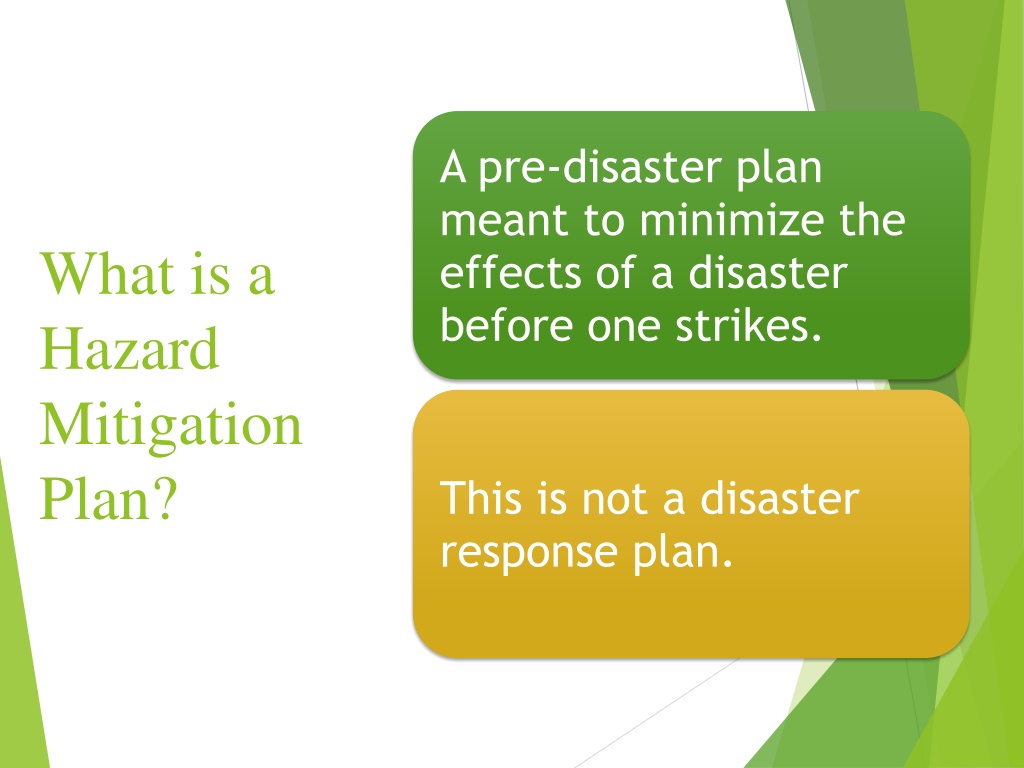



 undefined
undefined

